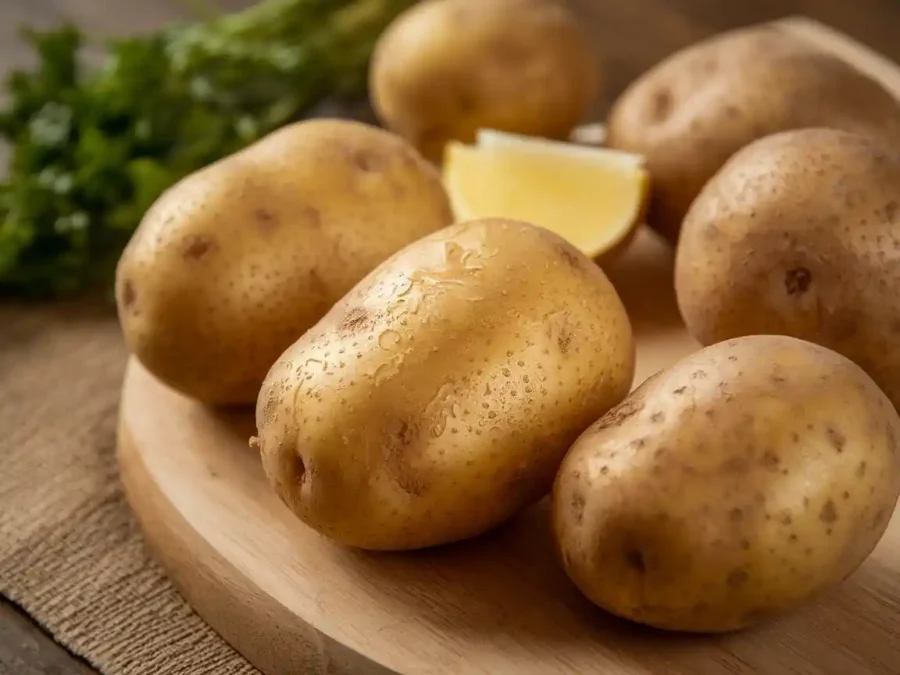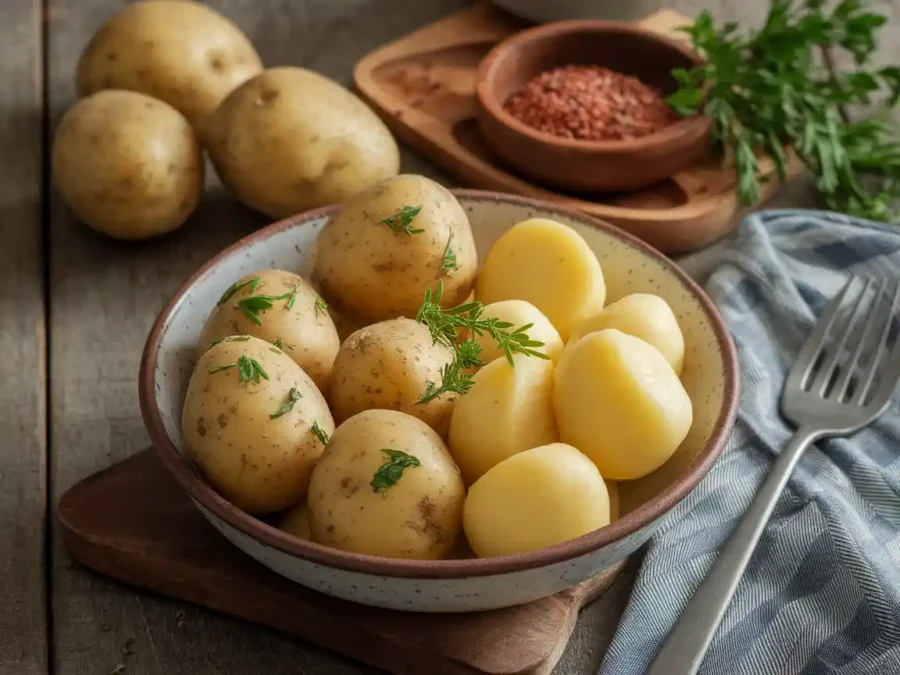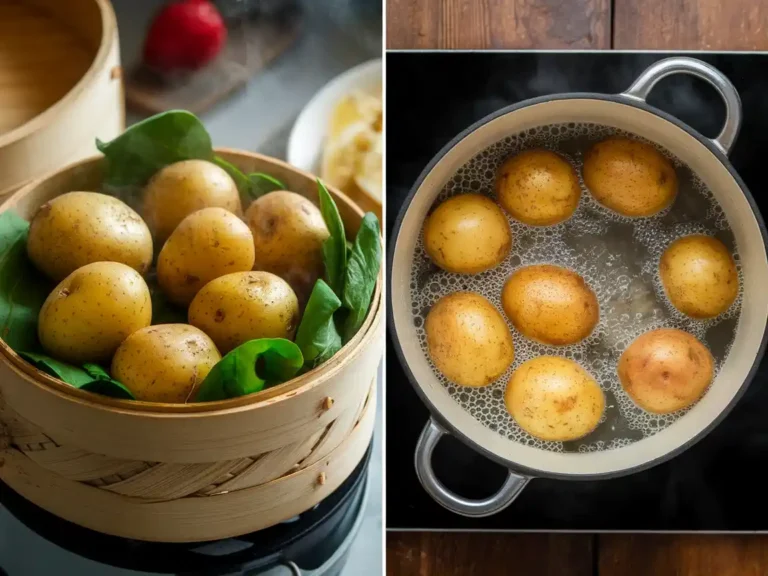Potatoes are one of the most versatile foods out there. You can mash them, roast them, fry them, or use them as the star ingredient in countless recipes. But when it comes to steaming versus boiling, which method comes out on top? Both techniques are classic ways to cook potatoes, yet they deliver different results in terms of taste, texture, and nutritional value. Let’s peel back the layers and find out which method best suits your needs.
Table of Contents
Introduction to Cooking Potatoes: Steam vs. Boil
Potatoes are a pantry staple for a reason they’re easy to cook, affordable, and packed with nutrients. But how you cook them can make all the difference. Steaming and boiling are two simple methods, but they’re not interchangeable.
Boiling involves submerging the potatoes in water and cooking them until tender. It’s the go-to method for making mashed potatoes, soups, or potato salads. On the other hand, steaming uses hot water vapor to cook the potatoes without immersing them in liquid. This method is prized for its ability to preserve the potato’s natural flavor and nutrients.
So, what’s the verdict? Spoiler alert: it depends on what you’re looking for flavor, health benefits, or ease of cooking. Let’s dive deeper.
Nutritional Impact of Steaming and Boiling Potatoes

Potatoes are already nutritional powerhouses, loaded with vitamins, minerals, and fiber. But the cooking method you choose can either retain or diminish these benefits. Here’s a closer look.
Retention of Vitamins and Minerals
One of the biggest differences between steaming and boiling lies in nutrient retention. When you boil potatoes, some of the water-soluble vitamins, like vitamin C and B6, can leach out into the water. While this isn’t a dealbreaker since potatoes are still nutritious even when boiled it does mean you’re not getting the full nutrient punch.
Steaming, on the other hand, is much gentler. Since the potatoes don’t sit in water, their nutrients stay intact. If you’re aiming to maximize your vitamin intake, steaming takes the lead.
“Think of steaming as nature’s way of wrapping up all the goodness in a potato, while boiling tends to share some of that goodness with the cooking water.”
Calorie and Fat Content Comparison
The good news is, both steaming and boiling potatoes are low-fat cooking methods. They don’t require oil, which keeps the calorie count minimal. However, the toppings or recipes you use can quickly change that! Whether you’re steaming or boiling, the potato itself remains a healthy, nutrient-rich option.
Taste and Texture Differences Between Steamed and Boiled Potatoes

When it comes to taste and texture, steaming and boiling produce distinct results. Your choice here depends on how you plan to serve the potatoes.
Fluffy vs. Firm: What Steaming Offers
Steaming potatoes gives them a slightly firmer texture compared to boiling. They hold their shape better, making them ideal for dishes where the potato needs to stay intact, like potato salads or roasted potato medleys. The flavor is also more pronounced because the steaming process preserves the potato’s natural taste.
Creamy and Soft: The Boiled Potato Experience
Boiled potatoes tend to have a creamier texture, which works well for dishes like mashed potatoes or soups. The extra moisture absorbed during boiling makes them easier to mash into that perfect, fluffy consistency we all love. However, if overcooked, they can become waterlogged and lose their natural flavor.
“Texture-wise, it’s like comparing a crisp apple to a ripe peach both delicious, but suited for different cravings.”
Cooking Efficiency: Time and Energy Considerations
When you’re hungry and want your potatoes ASAP, how you cook them matters. Both steaming and boiling have their pros and cons when it comes to time and energy efficiency.
Which Method is Faster?
If speed is your priority, boiling generally takes the win, especially for larger batches of potatoes. By fully submerging the potatoes in hot water, heat is transferred more quickly, allowing them to cook faster. Depending on the size of the potatoes, boiling can take 15–25 minutes.
Steaming, while slightly slower, is still relatively quick. You’ll need around 20–30 minutes to steam whole potatoes, but smaller chunks can cook faster. The bonus? You don’t have to babysit a steamer like you might with boiling water that can bubble over.
Energy Usage: Stove vs. Steamer
Energy-wise, steaming is often more efficient because it uses less water. Heating a large pot of boiling water can consume more energy and take longer. If you’re conscious of sustainability, steaming might be the better choice for your carbon footprint.
“Think of steaming as the ‘quiet achiever’ it gets the job done without wasting resources, all while keeping things clean and nutrient-packed.”
Common Problems When Steaming or Boiling Potatoes
No method is without its challenges. Steaming and boiling potatoes each have their pitfalls, but luckily, most issues can be avoided with a little know-how.
Overcooking and Nutrient Loss
Overcooking is a common issue with both methods. Boiled potatoes left too long can become mushy or waterlogged, which can make them less appealing and harder to use in certain recipes. Additionally, overboiling can further deplete the nutrients leached into the water.
Steamed potatoes are less likely to lose nutrients, but they can become too soft and fall apart if left in the steamer for too long. The key is to keep an eye on them when a fork slides in easily, they’re done!
Water Absorption in Boiled Potatoes
Boiling potatoes can lead to excessive water absorption, especially if the skins are removed. This isn’t ideal if you’re planning to use them in recipes like mashed potatoes, as the added moisture can dilute the flavor and create a watery texture.
Want a fix? Always boil potatoes with the skin on when possible. It acts as a natural barrier and helps retain their structure and flavor.
Undercooked Potatoes in a Steamer
Steaming requires a bit of patience, and rushing the process can result in undercooked potatoes. There’s nothing worse than biting into a potato that’s still firm in the middle! To avoid this, cut larger potatoes into smaller, even pieces before steaming to ensure uniform cooking.
“Cooking potatoes is like a balancing act too much or too little can ruin the show, but a little practice makes perfect.”
Health Benefits of Steamed vs. Boiled Potatoes
When it comes to health, both steaming and boiling are excellent methods. But each has unique advantages that cater to different dietary needs.
Managing Blood Sugar Levels
Potatoes are rich in carbohydrates, and the way you cook them can impact their glycemic index (GI) a measure of how quickly a food raises blood sugar levels. Steaming generally has a slightly lower GI compared to boiling, especially if you leave the skin on.
Boiling, on the other hand, can raise the GI slightly due to the potato absorbing more water, breaking down the starches more quickly. If you’re managing blood sugar levels, steaming may be the better option.
Potatoes in Low-Fat Diets
Both methods are virtually fat-free, making them ideal for low-fat diets. The difference comes down to what you add afterward. Steamed potatoes are often paired with lighter toppings like olive oil or lemon juice, while boiled potatoes are commonly mashed with butter or cream.
If you’re watching your fat intake, steaming offers a slight edge because it naturally pairs well with fresher, low-fat ingredients.
Suitability for Different Recipes
Different cooking methods shine in different recipes. Here’s how to decide whether to steam or boil based on your culinary needs.
When to Use Steamed Potatoes
Steamed potatoes are ideal for dishes where the potato needs to maintain its shape and natural flavor. They’re perfect for:
- Potato salads
- Side dishes with minimal seasoning
- Warm bowls paired with herbs and vinaigrettes
Their firmer texture and more concentrated flavor make them a hit in recipes that rely on the potato being the star.
When Boiled Potatoes Work Best
Boiled potatoes are best for recipes that call for creamy, soft textures. Think:
- Mashed potatoes
- Soups and stews
- Casseroles
Boiling makes potatoes more pliable, so they blend easily into creamy dishes, adding richness without overpowering the dish.
“Your choice of cooking method is like picking the right tool for a job each method brings out something unique in your potatoes.”
Frequently Asked Questions (FAQs)
When it comes to steaming versus boiling potatoes, people often have lingering questions. Let’s address some of the most common ones to clear up any doubts you might have.
Which method is healthier: steaming or boiling potatoes?
Steaming is generally considered healthier because it retains more nutrients. Boiling can cause some vitamins, like vitamin C and B6, to leach into the water. However, both methods are low-fat and can be part of a healthy diet.
Can I use the same potatoes for both steaming and boiling?
Absolutely! Most potato varieties, including Yukon Gold, Russet, and red potatoes, can be used for both steaming and boiling. Your choice will depend on the recipe and the texture you want to achieve.
What is the best way to steam potatoes without a steamer?
If you don’t have a steamer basket, don’t worry! You can place a colander or sieve over a pot of boiling water and cover it with a lid. Alternatively, use a microwave-safe bowl with a bit of water, cover it loosely, and microwave the potatoes until tender.
How do I avoid waterlogged boiled potatoes?
To prevent water absorption, always boil potatoes with their skin on. This acts as a natural barrier. Also, avoid overboiling test for doneness with a fork, and remove them as soon as they’re tender.
Does steaming take longer than boiling?
Steaming can take slightly longer, depending on the size of the potatoes and the equipment used. However, cutting potatoes into smaller, evenly sized pieces can speed up the process.
Can I reuse the water from boiling or steaming potatoes?
Yes! The leftover water from boiling potatoes is rich in starch and nutrients, making it perfect for soups, gravies, or even bread recipes. Steaming water can also be reused but may have a milder flavor.
Conclusion: Is It Better to Steam or Boil Potatoes?
When it comes to the ultimate debate is it better to steam or boil potatoes the answer depends entirely on your priorities. Both cooking methods have unique advantages, and each brings out different qualities in this humble yet versatile vegetable. Whether you’re looking for nutrient retention, optimal texture, or convenience, the choice between steaming and boiling isn’t about right or wrong it’s about what works best for you.
Steaming potatoes is often the preferred choice for health-conscious cooks. This method preserves more vitamins and minerals, especially water-soluble nutrients like vitamin C and B6, making it ideal for those prioritizing nutritional benefits. The firmer texture of steamed potatoes also makes them a great option for dishes like salads or as a side dish where the potato needs to hold its shape. Plus, steaming is energy-efficient, environmentally friendly, and versatile for various recipes.
Boiling, on the other hand, is unmatched for its simplicity and speed, especially when cooking large quantities. If you’re making mashed potatoes, creamy soups, or stews, boiling delivers a soft, fluffy texture that blends beautifully into these dishes. While some nutrients are lost during boiling, keeping the skin on can minimize this issue. Additionally, boiling provides a reliable, no-fuss method for preparing potatoes in everyday meals.
Ultimately, the decision comes down to your goals. Are you aiming to maximize health benefits and retain the potato’s natural flavors? Steaming is your go-to method. Or are you seeking a quick, easy way to prepare potatoes for hearty, comfort-food dishes? In that case, boiling might be the better choice.
“At the end of the day, whether you steam or boil potatoes, they remain a culinary staple that can elevate any meal, offering endless opportunities to explore your creativity in the kitchen.” 🥔✨
So, the next time you’re preparing potatoes, ask yourself: what’s the goal of the dish? By understanding the strengths of both steaming and boiling, you can ensure every potato you cook is perfect for your needs whether it’s a nutrient-packed side or a creamy, indulgent mainstay. And remember, the focus isn’t just on how you cook your potatoes but also on how you enjoy them, with all the delicious possibilities they bring to your plate.
Whichever method you choose, one thing is certain: potatoes are a timeless, versatile ingredient that never fails to satisfy.

